- Related material:
What breeds are giants
The number of varieties of giant rabbits is also diluted with breeds that can also be attributed to giants - gigantic. Giant rabbits grow much larger than giants. The following breeds can be attributed to large representatives of the genus of rabbits:
- white giant;
- gray giant;
- flandre (Belgian giant);
- butterfly (spotted giant);
- ram().
Features and characteristics of rocks
Rabbits of various breeds differ from each other not only in appearance, but also in size, wool, and their purpose.
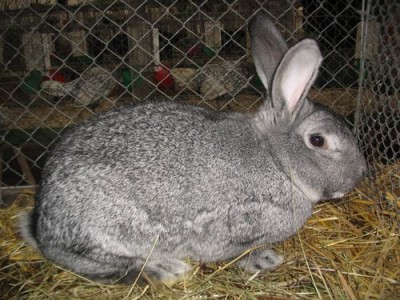
A breed that was bred as a result of work with Belgian albino rabbits in the 19th century. Rabbits of this breed have a snow-white color, red eyes, and fairly thick fur. The white giant is characterized by a strong body, the length of which ranges from 55 cm to 65 cm. As a rule, the average weight of a white giant is 5.3 kg. In industry, the skin of a white giant is used, because. it is easy to color. Also, this breed is used to breed and improve other breeds of giant rabbits.
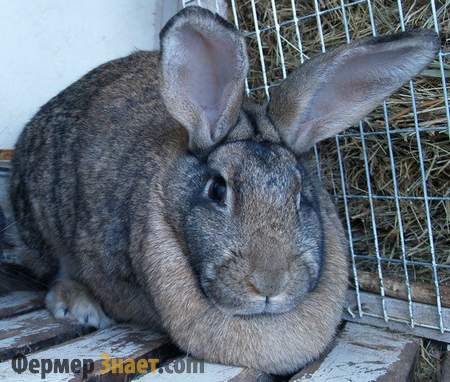
The breed was bred in 1952. The length of the body can reach 65 cm, and the weight ranges from 4.1 kg to 6.5 kg. According to the name of the breed, its fur is gray in color. However, due to the fact that the breed was bred relatively recently, there are both pure black and pure white individuals. Despite the uncharacteristic color for the breed, general characteristics they still fall into the category of gray giants. The advantages of this breed is their resistance to various diseases, as well as endurance low temperatures.
Butterfly

The breed was bred in the late 80s. characteristic feature This is its unique spotted coloration. Black spots of different sizes are symmetrically scattered on white fur, mostly spots are located on the back and sides. Butterflies are the smallest among the giants, their body length reaches a maximum of 60 cm, and the average weight is 4.5 kg. Representatives of this breed differ from others in their fertility and rapid growth. Their coat is thick, soft and due to its unique coloring does not require additional processing. Unfortunately, the breed is not as widespread as others.
Belgian giant or Flanders
 The most common breed in the world. It can be categorized as giant rabbits. Most of the other breeds came from the Belgian look. Flanders differs from other breeds in its mass and elongation of the body. In weight, animals can reach 12 kg. Color may be different. Due to its size, the Belgian animal gives a lot of meat. Another distinguishing feature of giant rabbits is their ears, the length of which reaches 18 cm. The disadvantages of the breed include late fertility, but females give large offspring.
The most common breed in the world. It can be categorized as giant rabbits. Most of the other breeds came from the Belgian look. Flanders differs from other breeds in its mass and elongation of the body. In weight, animals can reach 12 kg. Color may be different. Due to its size, the Belgian animal gives a lot of meat. Another distinguishing feature of giant rabbits is their ears, the length of which reaches 18 cm. The disadvantages of the breed include late fertility, but females give large offspring.
- Read also:

Content Features
Containment environment conditions
To grow rabbits of giants and giants, it is necessary to create favorable conditions for existence, only with proper care and the right environment, they grow up healthy and fit.
Containment environment conditions
They are kept in cages. The size of the cage depends on the breed and age category of the animal. So, for example, to keep one adult giant, you need a cage with a floor area of 0.6 sq.m. For young rabbits, a 0.12 sq.m. cage is suitable, because. young animals are prepared for slaughter and they need to provide the necessary space for activity. It is best if the floor of the cage is made of metal mesh, because. it is more convenient to clean it from feces. However, for giant rabbits there is a risk of catching pododermatitis.
The cage should have a place for a feeder and a drinker, and if the rabbit is a female, then also a maternity place. As a rule, animals are fed with hay and mixed fodder.
Cages can be placed outdoors, as giants tolerate cold well. But, if it is possible to place cells in the basement, then you can use it. In the basement, the rabbits will be cool in the summer heat, and not so cold in the winter cold. In severe frost, there is a chance that the animal will get frostbite.
Breeding methods
More about breeding: A distinctive feature of all giant rabbits is fertility. On average, for one round, a female giant can bring 8 cubs. Newborn rabbits weigh no more than 85 grams, but, with full feeding, after 1.5 months they reach a weight of 1.5. kg. If you use food with a high protein content for feeding, then at 2 months the rabbit will weigh about 2 kg. With such nutrition, giant rabbits develop faster, and the quality of their meat increases by 50%.
Usually the success of breeding giant rabbits lies precisely in proper nutrition, timely vaccination, clean conditions.
Vaccination: pros and cons
Remains open. Some argue that rabbits do not need to be vaccinated, saying that no one had vaccinated them before, but they still grew strong, healthy and were in demand. Others believe that vaccinations reduce the risk of various diseases, and also affect the quality of meat and the condition of the animal's skin. The decision to vaccinate is up to the owner. http://youtu.be/cHlr38FQrB4?t=53s
Features of care
The first and most important point is cleanliness. Rabbit cages should always be clean, because the dirt accumulated in them is a real haven for bacteria and viruses that the animal can pick up. It is best to fill the cells with sawdust, they absorb moisture and eliminate unpleasant odors. The sawdust should be changed once a week. The second point is the diet of the animal. You should not feed the giants with spoiled food, rotten food and various other food waste. The modern range of pet products provides a lot of different feed for different breeds. However, all these feeds do not differ much from each other in their composition, therefore, rather, separate feeds for different breeds of giant rabbits are a pure marketing ploy. In addition, rabbits love oats and barley. In no case should you give them wheat, the probability of death of the animal is high.
How to choose and where to buy
When choosing, keep in mind that each rabbit has its own purpose. There are fur, meat and decorative species. Fur breeds include gray giant, white giant, butterflies. The best are the Belgian giants, they give the most meat. When buying in the markets, it is better to first familiarize yourself with the breeds and their characteristics, because. often market sellers like to cheat. For example, they pass off all spotted rabbits as, although by weight they may not even belong to the giant variety. It is best to purchase animals from private rabbit breeders or in nurseries. So, on the spot, you can see in what conditions the animal is kept, how it looks, and choose the right one. The animal must be examined for the following points:
Prices for rabbits fluctuate depending on their breed, weight and age. As a rule, for young and females they take a little more. So, for example, the average cost of rabbits from 2 months in the Moscow region is from 400 rubles per month. Usually, prices are for one month, so for example, if the pet is older, then the price for the month is multiplied by its age.
Giant rabbits are one of the largest representatives of the rodent order. To date, many breeds have been bred that reach enormous sizes, which allows you to increase the amount of meat and fur obtained. In this article, we will tell you about which species belong to the giants, about some of their features, as well as about the method of keeping animals at home.
What breeds are giants
Giant rabbits have several dozen different breeds that can be kept on farms in different countries. Each species is bred in the climate to which the rabbits are best adapted. This affects their growth rate, the appearance of diseases, as well as the quality of fur and meat.
The most popular types of such rabbits in the CIS countries are the Gray and White giant. With a large weight, and a good growth rate, they require special care. The giants also include Flandre, Butterfly and Baran.
Species Features
White giant. It was bred by German breeders in the 20s of the last century. For a long time, farms have tried to breed a rabbit that would have a graceful body structure and improved quality of meat and fur.
German breeders have done a great job of improving this species. They crossed albino Flanders with Gray Giants and White Chinchillas. As a result, it was possible to breed rabbits that have a stable immunity to various diseases, and females have good maternal instincts. This made it possible to quickly increase the productivity of animals on German farms.
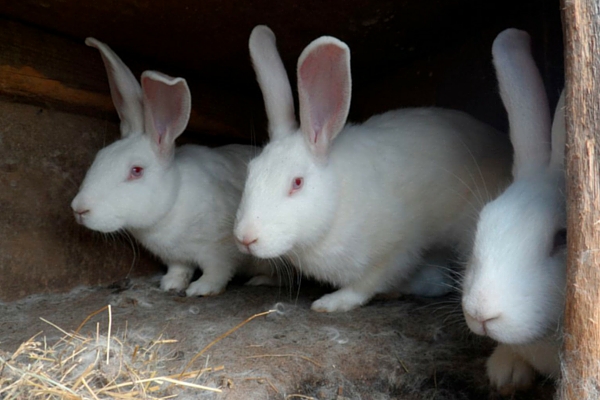
The white giant is capable of reaching enormous sizes and has excellent fertility. Females for one offspring can bring 7-9 babies, and sometimes up to 15 individuals.
This species has very good and high-quality wool. According to the characteristics of the fur, the skin of this variety of rabbits is considered one of the best. It has an exclusively white color with no other shades. Since German breeders used albinos when breeding this species of animals, the eyes of the White Giant are red.
The following parameters should be attributed to the features of the German species: straight ears, large light head, strong paws and body constitution, large sternum.
This species feels good in the continental climate, so these rabbits can be bred in central Russia.
It is important to note that unlike many other species, these rabbits do not eat their own droppings. They gain weight quickly. After 2 months, the cub can weigh about 2 kilograms. Adults can reach up to 5-6 kilograms.
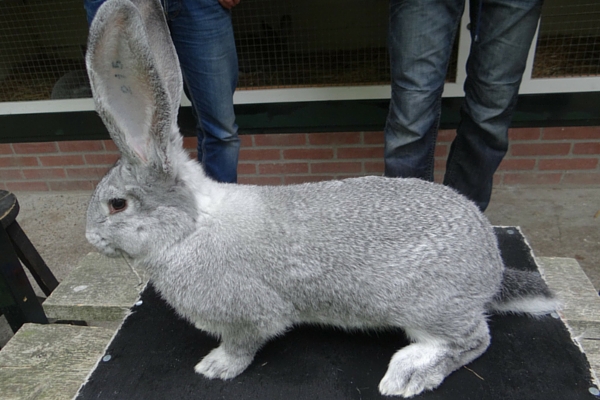
Gray giant. These rabbits were bred in Ukraine in the 50s of the 20th century. Breeders crossed Flanders with local outbred rabbits. As a result of long work, most of the characteristics were transferred from Flandres. The species has acquired the ability to adapt well to environment. Also, the Gray Giant received good fertility from other animal species.
Animals have a variegated gray fur color with different shades. Sometimes a light gray female may have white or black rabbits. This coloration is considered normal.
On average, giant rabbits weigh 5-6 kilograms, but some individuals can reach 7 kg. The length of the body of the animal is about 60 cm.
The gray giant has a strong body constitution with a massive skeleton. Representatives of this variety of giants have a large head and wide ears, large and strong paws. The coat is somewhat inferior to the German species as it is shorter and not as thick. The quality of their undercoat is somewhat inferior to those animals that are bred at home for the sake of obtaining valuable fur.
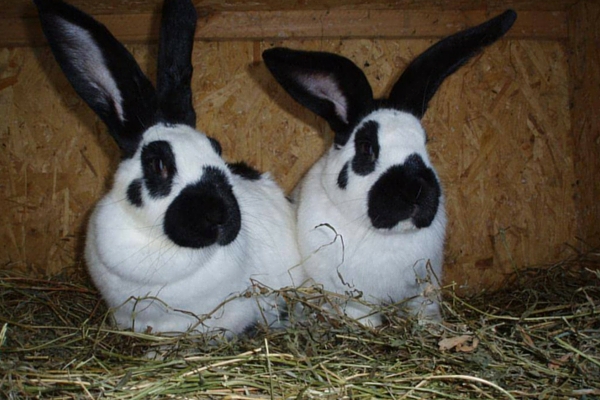
Butterfly (German motley giant). The motley giant was bred only at the beginning of the 20th century by German breeders. A characteristic feature of these rabbits is a variegated color. They often have black spots on white fur, which are not symmetrically distributed throughout the body, mainly on the sides and back.
Representatives of this motley variety are distinguished by good fertility, intensive growth. Wool does not require additional processing, as it has a unique variegated color, very soft and thick.
The average weight of an adult is up to 4.5 kilograms. The motley giant can be kept at home in cold climates.
The motley giant is also called the "butterfly" because it has a characteristic black spot on its nose, similar to the wings of a butterfly.
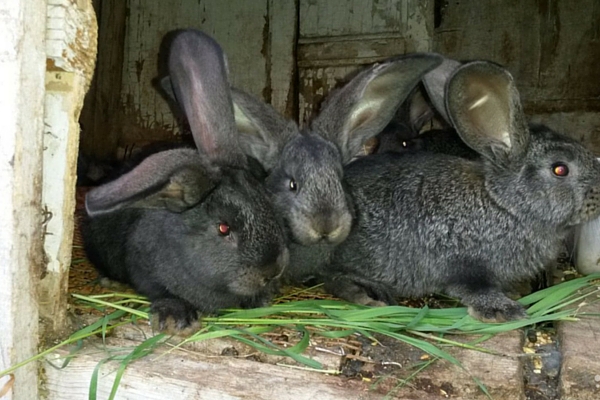
Flanders. Belgian giant rabbits are considered the most common in the world. They became the progenitors of most modern species that are fed at home. Usually Flanders has a gray color.
When bred on a farm, an animal can reach 12 kilograms in 10-12 months. Females have a good offspring, but fertility is quite late. However, their maintenance on the farm does not always have a good profitability, since the average meat yield is about 55-60%. At the same time, Flanders is constantly hungry, which requires a large number feed and hay for their maintenance.
Video "Examination of a rabbit German motley giant"
This recording of a rabbit breeding seminar will introduce you to the expertise appearance giant rabbit breed Butterfly.
Breeding and keeping
Breeding and keeping giant rabbits at home is a very profitable occupation.
White giants can be kept in cages that are customary to install on the street. They are very hardy, tolerate low and high temperatures, humidity change. It is best to keep them in the shade. Often, for greater comfort of animals, they are kept in sheds or basements.
It is important to pay due attention to the cleaning of the cages, because in an unfavorable environment, rabbits may develop unpleasant diseases. If the cages are not kept clean, large rabbits are more likely to develop pododermatitis, mastitis, etc.
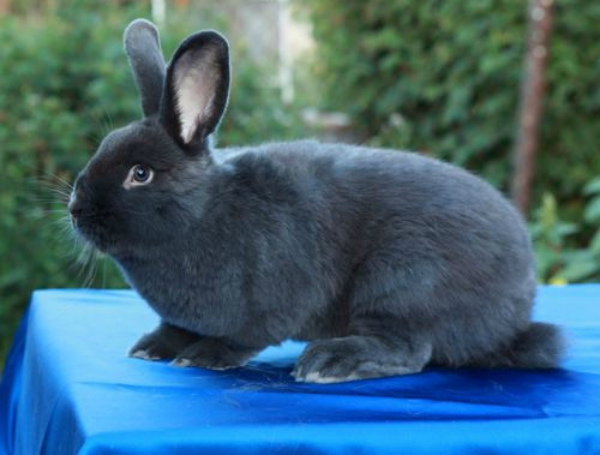
In the cages where rabbits live, it is necessary to equip a feeder and drinker. It is important that animals always have clean water if the main diet is hay and mixed feed.
Flanders and the Gray Giant are best kept in dry rooms, as not all species are equally resistant to temperature extremes.
For normal feeding of one individual, an average of 0.15 m 2 is required. Such space is necessary for the animal to support normal level activity if it is grown for slaughter.
Breeding giants is also very important for the farmer. Breeding can begin when the animals reach the age of 6-7 months. To increase the number, it is best to select the largest and most active individuals that do not have physiological defects.
The mating of rabbits is desirable to be carried out on the territory of the male. If the female does not let anyone near her for a long time and behaves aggressively, then this means that she is pregnant. is one calendar month. The female begins to prepare a place for newborns 1-2 weeks before birth. Mostly all large species of rabbits have good maternal instincts, which does not cause trouble for the farmer when breeding them at home.
Cultivation and care
Feeding giant rabbits of different species is not much different from each other. If the animals are walking on pastures, they can get enough protein. When kept only at home, they need to make concentrated feed additives.
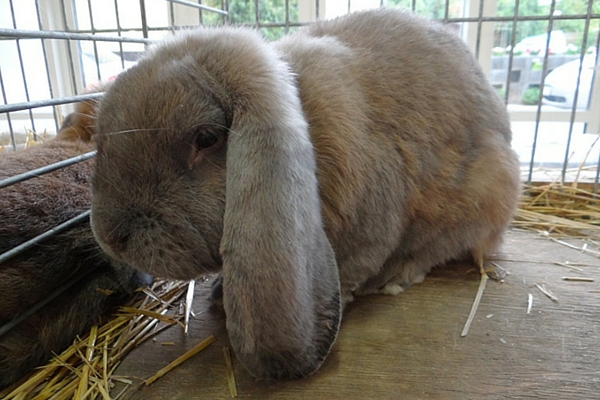
If you use compound feeds with a high content of proteins when fattening, then in a month and a half the rabbits will grow up to 1.5-2 kilograms.
Usually, on large farms, feeding rabbits consists of oatmeal or crushed barley groats, fresh and dried grass, boiled vegetables (potatoes, carrots), and dried bread. These products saturate the animal well and are perfectly digested.
In the summer, while feeding the rabbits, fresh grass can be added to the crushed grain. They eat almost any grass, but it is better to choose the most juicy varieties - dandelions, quinoa, wormwood, wheatgrass, plantain, nettle. You can also eat carrot and beet tops. Animals may develop bloating or diarrhea when consumed in large quantities. To avoid the manifestation of symptoms of disruption of the gastrointestinal tract, the grass should be dried for 2-3 days before giving it to animals. Wet grass should not be eaten; it must be dried before being eaten.
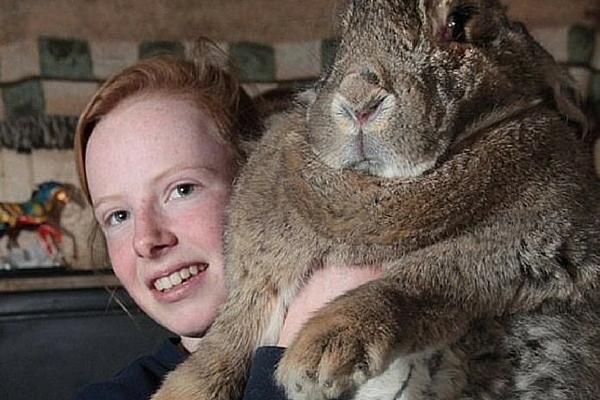
Rabbits' diet may include fruits and vegetables, young shoots, and tree branches. Carrots and cabbage are very useful for the gastrointestinal tract of animals, and it can be given to them in any quantity. Also, rabbits eat zucchini, pumpkin and root crops well.
Giant rabbits are real giants in the world of rodents. The weight of representatives of these breeds reaches 5-6 kg, and the largest specimens - up to 10 kg. There are many varieties of these animals, but in Russia the white and gray giants are the most popular. Why? Yes, because they do not require special conditions of detention, are extremely unpretentious in food, and bring a good income.
There are two types of rabbits of large breeds: "giants" and "giants". The first group includes only two varieties: gray and white giants.
Rabbits are considered giants:
- Soviet chinchilla;
- butterfly;
- giant angora;
- german sheep.
Often, giant rabbits grow much larger than giants. For example, the rabbit Ralph, a representative of the Flanders breed, listed in the Guinness Book of Records, weighs more than 19 kg.
Breed features
Each breed of giant rabbits has its own distinctive features. Often, their breeding at home is aimed at obtaining a large amount of meat products, however, some representatives of giant breeds are also distinguished by a luxurious fur coat.
Flanders
 Representatives of the Flanders breed stand out among other rabbits for their truly gigantic size. These massive animals have a strong body with muscular legs and an arched back, as well as long, wide ears that distinguish them from other breeds.
Representatives of the Flanders breed stand out among other rabbits for their truly gigantic size. These massive animals have a strong body with muscular legs and an arched back, as well as long, wide ears that distinguish them from other breeds.
Peculiarities:
- light grayish color of the skin;
- the weight of an adult animal is 9–12 kg;
- body length - 70–72 cm;
- the female brings 6-8 rabbits at the same time.
This is a meat breed with low quality skins.. Despite their massiveness and strong physique, Flanders are very susceptible to environmental conditions. They are often exposed to infectious diseases, so they need to be kept in spacious cages with warm bedding and a solid floor. The bottom of the lattice or mesh is categorically not suitable, because because of its considerable weight, the rabbits rub their paws on it and get sick with various dermatitis.
Chinchilla- one of the most valuable varieties of giant rabbits, because in addition to meat products it gives surprisingly thick warm fur with a silvery sheen. This breed appeared as a result of crossing chinchilla rabbits with white giants.
Breed and its features:
- soft dense fur with a silver-blue tint;
- the mass of an adult rabbit is 5–8 kg;
- body length - 60–65 cm;
- the rabbit brings 7-10 cubs at the same time.
This breed is undemanding to the climate: thanks to thick fur, animals perfectly adapt to low temperatures. But such rabbits do not tolerate drafts and exposure to sunlight: they often get sick, grow weak, and gain weight more slowly.
german ram
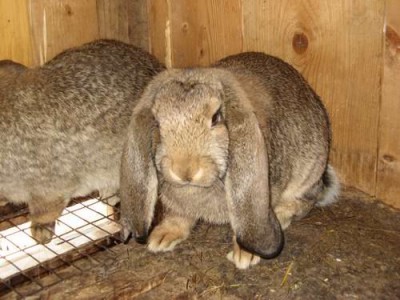 This breed was bred as a result of crossing large representatives of the breed with Flandres. A distinctive feature of these animals is hanging ears and a wide muzzle. Since their fur does not have a developed undercoat and is not very dense, such breeds are considered meat.
This breed was bred as a result of crossing large representatives of the breed with Flandres. A distinctive feature of these animals is hanging ears and a wide muzzle. Since their fur does not have a developed undercoat and is not very dense, such breeds are considered meat.
Peculiarities:
- the weight of an adult rabbit is 4–10 kg;
- body length - 60–70 cm;
- the rabbit brings 4-7 rabbits at the same time.
Such rabbits are more suitable for decorative purposes, as they are extremely whimsical to the conditions of detention. For animals to develop normally, get sick less, they must be protected from sources of heat and moisture, put shelter houses in cages. Vaccination is also essential here.
giant angora
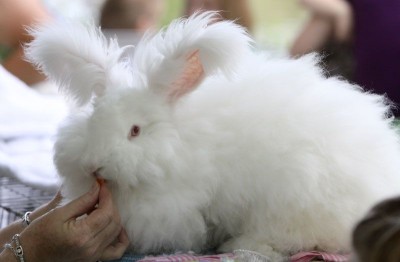 Rabbits of this breed are valued not for meat and skin, but for surprisingly light and warm fur. That is why growing giant angoras at home requires a special approach: if not properly cared for, valuable fluff will fall into tangles and become unusable.
Rabbits of this breed are valued not for meat and skin, but for surprisingly light and warm fur. That is why growing giant angoras at home requires a special approach: if not properly cared for, valuable fluff will fall into tangles and become unusable.
Peculiarities:
- have increased fluffiness (wool reaches a length of 12-15 cm).
Every 3 months, such an animal can be sheared, collecting up to 200 g of valuable fluff.
Butterfly
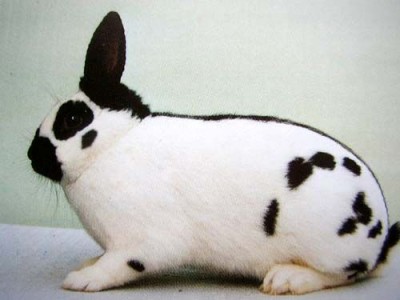 These large white rabbits with ingeniously arranged dark spots are bred at home both for meat and for the sale of skins. A large variety of this breed appeared as a result of crossing with flanders and white giants.
These large white rabbits with ingeniously arranged dark spots are bred at home both for meat and for the sale of skins. A large variety of this breed appeared as a result of crossing with flanders and white giants.
Peculiarities:
- variegated black and white skin;
- the weight of an adult rabbit is 4.5–5 kg;
- body length - 55–60 cm;
- the female brings 8-10 rabbits at the same time.
Such rabbits perfectly adapt to any climatic conditions, are distinguished by good immunity to colds and infectious diseases, feel equally comfortable in both cold and hot rooms.
It is best to keep these animals not in the barn, but in the fresh air. This will have a beneficial effect on the quality of the skin.
Keeping and breeding at home
Most giant rabbits do not require special conditions of detention. The requirements for their breeding remain the same as for breeding and. However, you need to understand that when buying rabbits of giant breeds, cage sizes and feeding should be reviewed.
Cages for giant rabbits
Giant breed rabbits should not be pitted. They require increased attention of the owner, which is not feasible in a pit environment.
Giants are different from. Cages with animals of meat-skin breeds should be placed in the fresh air - this will have a good effect on the quality of the skins. But meat breeds are best kept in the basement: in summer it will be cool enough in such a room, and in winter there will be no drafts. The main thing is that moisture does not accumulate in the basement.
Animals of giant breeds do not tolerate crowding, so they cannot be kept in standard cages.
Cage Requirements:
- cage dimensions for a male rabbit - 80 × 100 × 65 cm;
- cage dimensions for a rabbit with cubs - 100 × 150 × 65 cm;
- a solid floor covered with straw or sawdust so that the animals do not injure their paws or get corns;
- cleanliness, dryness, absence of an unpleasant smell;
- no drafts or overheating.
Giant breed rabbits are not kept in groups. Each individual must have an individual room to avoid fights and death of animals.
Watch an interesting video showing the original cage for giant rabbits.
Feeding
Now pet supply stores offer a huge selection of food for giant rabbits. There is absolutely no need to buy food for a particular breed. Their composition is approximately the same, so any of these products can be fed to giants. And here compound feed for ordinary rabbits is not suitable here. They do not contain the necessary complex of nutrients, therefore they will not be a balanced and complete diet for rabbits of large breeds.
Like normal rabbits giants need to be fed fresh vegetables, grain, hay. Their diet should include:
- barley and oats;
- hay and silage;
- roots;
- green grass;
- cabbage;
- legumes;
- branches, twigs for sharpening teeth.
Large rabbits should not be fed:
- rotten feed;
- spoiled products;
- food waste from the host's table;
- grains of wheat or products from it.
In any case, the owner of giant fluffies should be prepared for the fact that feeding pets will cost him a considerable amount.
Breeding
 giant breeds can only be carried out when the animals have reached sexual maturity. And if the rabbits small breeds it occurs at the age of 4–5 months, then in giants it occurs much later - at 7–8 months.
giant breeds can only be carried out when the animals have reached sexual maturity. And if the rabbits small breeds it occurs at the age of 4–5 months, then in giants it occurs much later - at 7–8 months.
Despite such a long waiting period, the owner of giant rabbits will be rewarded with: these animals are very prolific. One female brings from 7 to 10 cubs at the same time (the exception is the German ram).
Rabbits of giant breeds are not good at raising their own offspring. They do not have a developed maternal instinct, so they may not build a nest or forget about feeding the cubs. The rabbit breeder needs to be especially careful during the birth of pets: he must independently open (the uterine compartment) and, if necessary, make a nest or put the rabbits to the rabbit for feeding.
At the same time, rabbits of giant breeds never eat their cubs, and they have enough milk to feed all the offspring.
If everything went well, and in the first days the rabbits did not die, then by 1.5 months they will become more independent. Their mass during this period will reach 2 kg. If protein-rich foods are added to the feed, the rabbits will grow very quickly.
The rabbit stops feeding the cubs after 1.5 months, after which they can be placed in a separate cage. Now the female is ready to mate again.
Possible diseases
Diseases
The body of these animals is very fragile, which is why they are prone to many diseases. The most dangerous for them are infectious diseases, which in a few days can destroy the entire livestock:
- pesterellosis;
- myxomatosis;
- fasciolosis;
- listeriosis;
- tularemia;
- infectious rhinitis.
Common noncommunicable diseases include colds(rhinitis, pneumonia) diseases of the gastrointestinal tract(poisoning, bloating, constipation).
Prevention
To prevent the development of these diseases, the owner of the rabbit farm can take the following measures:
- provide comfortable living conditions for animals;
- maintain air ventilation;
- regularly change the bedding, remove spoiled food, stagnant water;
- disinfect the room in which animals live;
- constantly inspect rabbits, adults;
- prevent penetration into the cages of mice and birds - the main peddlers infectious diseases.
In addition, the owner of the rabbit farm should not neglect the vaccination of animals.
Vaccination
The owner decides whether to vaccinate his animals or leave them unvaccinated. Indeed, a few decades ago, vaccines were not used, and the animals were strong and healthy. On the other hand, vaccination helps to reduce the risk of developing many infectious diseases, which can lead to the death of the entire livestock.
The specificity of the content of breeds white and gray giant
 White and gray giants- the result of crossing Flanders with Russian breeds, which were distinguished by high vitality. Thereby distinctive features of white and gray rabbits become:
White and gray giants- the result of crossing Flanders with Russian breeds, which were distinguished by high vitality. Thereby distinctive features of white and gray rabbits become:
- high fertility;
- ability to reproduce quickly;
- rapid weight gain;
- adult weight - 4.5–6.5 kg;
- body length - 55–65 cm;
- high viability, resistance to adverse environmental conditions.
If the gray giant is considered a meat breed, then the white one belongs to the meat-skin varieties.
Breeding and keeping
White and gray giant rabbits adapt perfectly to any environmental conditions, and their thick fur protects them from exposure to low temperatures. That is why these breeds are so popular among residents of the northern regions.
Breeding white and gray giant rabbits requires the following conditions:
- spacious cages located on the sunny side, but protected from direct sunlight;
- lack of drafts;
- cleanliness, low humidity.
The cages of such rabbits should be regularly disinfected with freshly slaked lime or a 10% chlorine solution.
Feeding
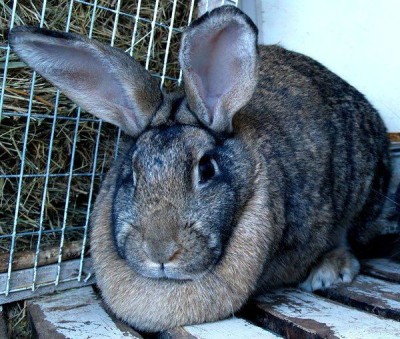 Rabbits of breeds white and gray giant require a varied, balanced diet with the inclusion of animal feed, grains, vegetables, hay. Their specific feature is that they drink much less water than rabbits of other breeds, and the lack of fluid must be compensated with the help of a properly selected "menu".
Rabbits of breeds white and gray giant require a varied, balanced diet with the inclusion of animal feed, grains, vegetables, hay. Their specific feature is that they drink much less water than rabbits of other breeds, and the lack of fluid must be compensated with the help of a properly selected "menu".
The diet of an adult rabbit of these breeds should include:
- vegetables (potatoes, squash, pumpkin), fruits (apples, pears);
- grain, seed mixtures;
- grass, hay (quinoa, nettle, corn stalks, tops of garden plants);
- dried bread.
It will not be superfluous to add to the feed vitamin complexes, salt,
If possible, in the summer you can walk the animals on the pasture. This will help to avoid beriberi, inevitable after a long winter. However, you need to avoid fields that grow poisonous plants dangerous for rabbits.
Diet norms:
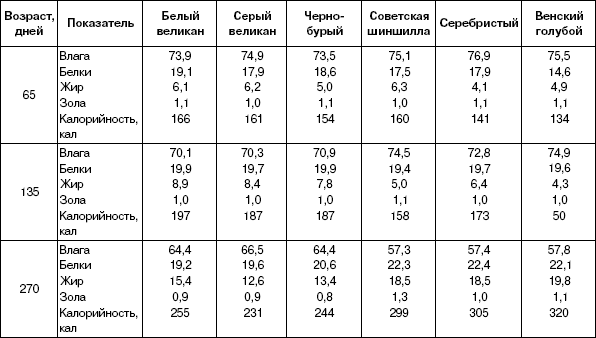
Advantages and disadvantages of white and gray giant breeds
Advantages of breeds:
- fertility;
- fast weight gain;
- resistance to infectious diseases;
- viability;
- females do not trample and do not eat offspring.
The disadvantage of the gray giant breed is poor-quality skin which is of no value to buyers.
How to choose and where to buy
You need to buy rabbits for breeding in nurseries or from private rabbit breeders. In the market, the buyer can be deceived by giving out a large rabbit for a representative of a giant breed.
It is not so difficult to choose a healthy rabbit: it is enough to assess the condition of his eyes, nose, fur, and genitals. Purebred animals are much more difficult to buy. It must be remembered that the weight of an adult rabbit should be in the range of 5-7 kg. If the animal weighs less, there is a chance that the buyer will become the owner of a completely ordinary, not giant rabbit. An animal with a large weight also does not need to be bought: it is not suitable for reproduction.
We are all used to the fact that rabbits are something small, fluffy and cute. However, in this moment, you can find many breeds of giant rabbits. Breeding of these breeds began in Western Europe, and in Russia, giant rabbits began to be bred in the post-war period, in order to search for food.
Rabbits breed gray giant
Giant rabbits are distinguished and favorably distinguished by such features as rapid reproduction, maximum weight, large body structure and high vitality. In this article, we will tell you in more detail about the following giant rabbit breeds:
- Grey;
- White;
- Belgian;
- Blue;
- German.
Before you start studying giant rabbit breeds, we want to draw your attention to the rules for choosing a breed for breeding.
Before you start breeding a particular breed, decide on the purpose of breeding: are you interested in rabbit meat, wool, or do you want to breed rabbits for no particular purpose, but only for your own pleasure.
After you determine what interests you the most, you will make the most of your time reading this article, as in it we will draw your attention to certain advantages of a particular breed of rabbits.
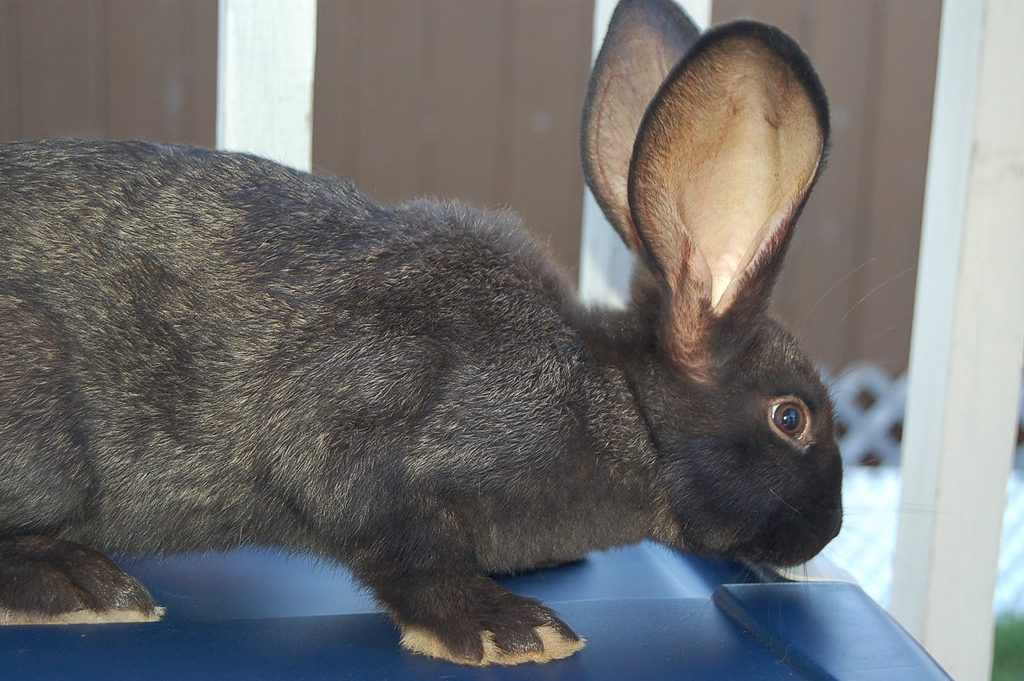
Flanders rabbit
Gray rabbit giant
The giant gray rabbit reaches a weight of 5 to 7.5 kg. and is recognized as the very first giant rabbit that was ever bred. The advantages of this breed should be called the fact that they are unpretentious in care and even exceed the weight of 7 kg.
They got their name because of the color of the coat.
white rabbit giant
The giant white rabbit began to breed after gray rabbits and the purpose of breeding this breed was to get more tender meat And best quality wool. The disadvantages of this breed are poor fertility and poor vitality. We know that after crossing this breed with chinchillas, many problems were solved, but one should be careful when choosing white rabbits for breeding.
![]()
Rabbit breed White giant
Belgian giant rabbit
This type of giant is also called "Flanders" after the name of the area (Flanders, Belgium), in which it was bred. Please note that this is the most large breed rabbits. Flanders need special care and look no less special: they are distinguished by ears that become spherical towards the ends. The Belgian rabbit is one of the giants because it is much larger than the bred species that preceded it.
Its weight reaches 12 kg., Sometimes more (the record in weight is 25 kg.). The body of the Flanders is long (67 cm), the chest is wide, and the color can take on a variety of shades of gray (from yellow to gray).
The Flanders eat a lot and are picky eaters. Keep in mind that you will also need ample space to breed Flanders. But they will repay you with excellent fertility (from 6-12 rabbits per litter) and the quality of the fur (the fur is dense, tall and thick). In addition to meat and fur, Flemish skins can be used to imitate the skins of more valuable animals, such as beaver, kangaroo, cat.
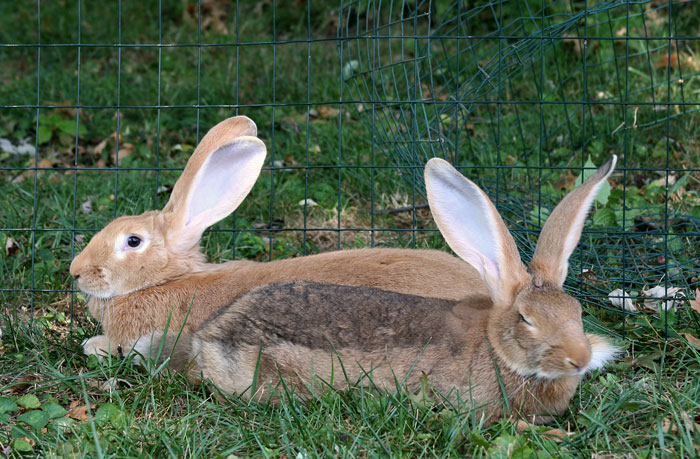
Flanders have a variety of colors
Blue rabbit giant
This species is also called the Viennese, and its representatives weigh from 3 to 5 kg. Blue giant rabbits are distinguished by dense and gray fur, and the pluses are the quality of meat that you can get, rapid growth and fertility.
German giant rabbit
Perhaps, this species can be recognized as the second most popular among rabbit breeders, after the Belgian. You can also meet that they are called "Riesen", which in German means giant. Rizen weight can reach 12 kg., And growth in length - 70 cm. Now you can meet different types rizenov: gold, blue or white rizen.
Experienced rabbit breeders prefer this species when they participate in exhibitions.
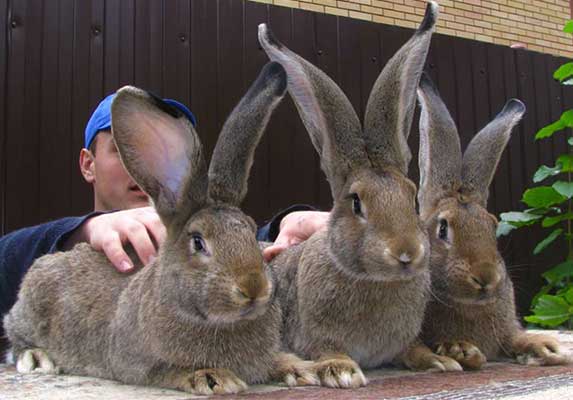
Rabbits breed German giant
The breeds mentioned above are clearly different from simple breeds of rabbits, and, accordingly, require special care. A few rules will help you:
- Before purchasing this or that breed, be sure to consult experienced rabbit breeders about how well this breed is compatible with the climate zone in which you live. Sometimes, after moving to another climatic zone, the animal weakens, does not take root.
- Remember that giant breeds require spacious cages and rooms, and more food. However, keep in mind that, compared to ordinary rabbits, they are less whimsical to care for and more resilient.
- These animals must be able to stand up on their hind legs. Make sure that the cells are high. The cage itself needs to be filled with something soft, like straw.
- Stock up on a brush to comb the fur and sharp scissors to trim the claws of the animal.
- Prefer ceramic dishes to put food for your animal in, and most importantly, make sure that there is always water in the water bowl.
- Scatter branches of trees around the cage, preferably fruit trees, so that the animal can always nibble when it wants to.
Rabbits of the Gray Giant breed were first obtained as an independent breed by domestic breeders in the early 1950s. The work was carried out in Ukraine at a fur farm and consisted of crossing outbred individuals with the Belgian Flanders breed. The result pleased not only the scientists of the former Soviet Union but also grateful breeders.
The resulting breed, which today is known as the Gray Giant, was distinguished by its large body weight and fertility, large size and excellent tolerance of adverse weather conditions. To this day, many rabbit breeders want to grow giants on their farms. Unpretentious in regards to carerabbits Gray Giant, breeding and keeping at home , as well as the features of feeding, are discussed in the article.
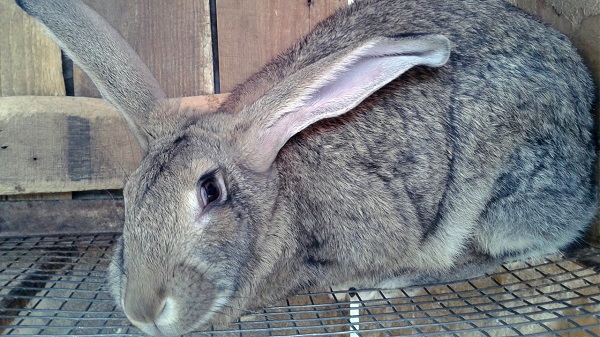 The live weight of Gray Giants can reach more than 7-7.5 kg.
The live weight of Gray Giants can reach more than 7-7.5 kg. Description, photos and features of rabbits Gray Giant
The breed of giant rabbits belongs to the meat-and-skin direction, which are distinguished by a thick gray, white or black coat color. The presence of a red or black shade in the gray color is allowed. The paws and belly of the animal are white. The nature of this breed is calm and meek.
Most breeders are interested in the weight of this fluffy animal. The live weight of Gray Giants can reach more than 7-7.5 kg. However, most often the average weight of one individual is 6 kg, and the body length is 70-75 cm. Giant rabbits have a large, massive build, a large head with straight ears, and their bones are large and strong. Gray rabbits have rather large breasts. In diameter, its size can reach 36-41 cm. The back is straight and wide, and the hind legs are powerful and long.
Females are distinguished by precocity and fertility. Able to give birth to an average of 8 rabbits once. Rabbit breeders report cases when there were 14 babies! Each cub weighs about 75-85 grams at birth, is characterized by rapid growth, provided that it is fed with a complete, high-calorie food.
In the proposed list, you can see the growth rate of young animals:
- 2 months - 1.5 kg;
- 3 months - 2 kg;
- 4 months - 2.5 kg.
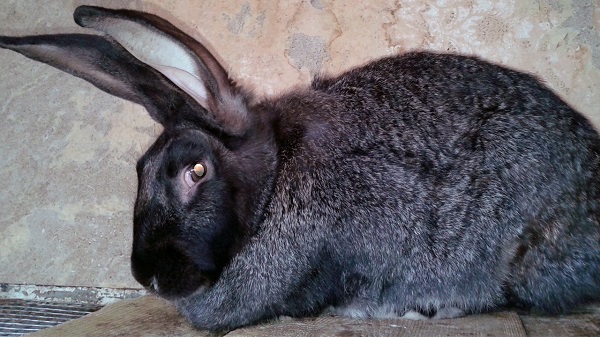
If you feed rabbits of the Gray Giant breed with protein-containing food with an increased rate, then weight gain will be more intense. In this feeding mode, the rabbit will gain about 3 kg in weight at 3 months. By giving high-quality feed, the animals will improve not only development, but also the quality and taste of meat.
Breeding and keeping rabbits Gray Giant at home
According to the reviews of breeders, it can be concluded that breeding the Gray Giant breed is beneficial due to the fertility of females and the large body weight of grown rabbits. In addition, they consider it a great advantage that rabbits do not eat babies and do not need to create special conditions for breeding. It is enough to place the female in the same cage with the male and wait for mating. At this point, it is desirable to remove all food and drinkers from the cage with water. 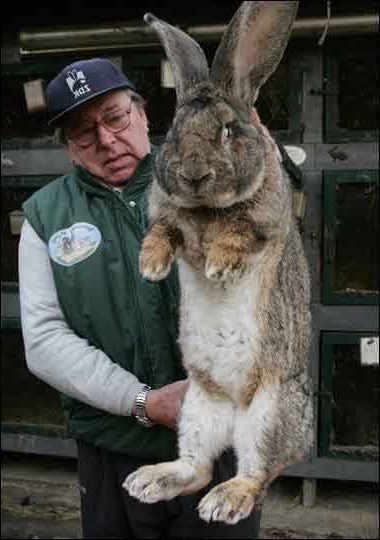
The first mating for breeding is allowed at approximately 5 months. The crawl matures a little later, and the male is allowed to mate from 7 months. It is recommended not to overexpose any more, especially females. First, it is economically unprofitable. Secondly, from 5-6 months, rabbits practically stop growing, and gain weight due to fat mass. The fatter the female, the more difficult it is for her to fertilize.
With regard to keeping rabbits Gray Giant, it is worth remembering such basic rules, namely:
- raise rabbits in spacious cages;
- keep the rabbitry clean;
- it is good to heat during cold weather;
- eliminate drafts and dampness;
- provide enough clean water.
Rabbits love warmth and have good health in conditions of observance of primitive sanitary and hygienic standards. It is recommended to clean the cages in a timely manner and periodically but regularly disinfect them with a weak bleach solution or burn the cages with a blowtorch.
